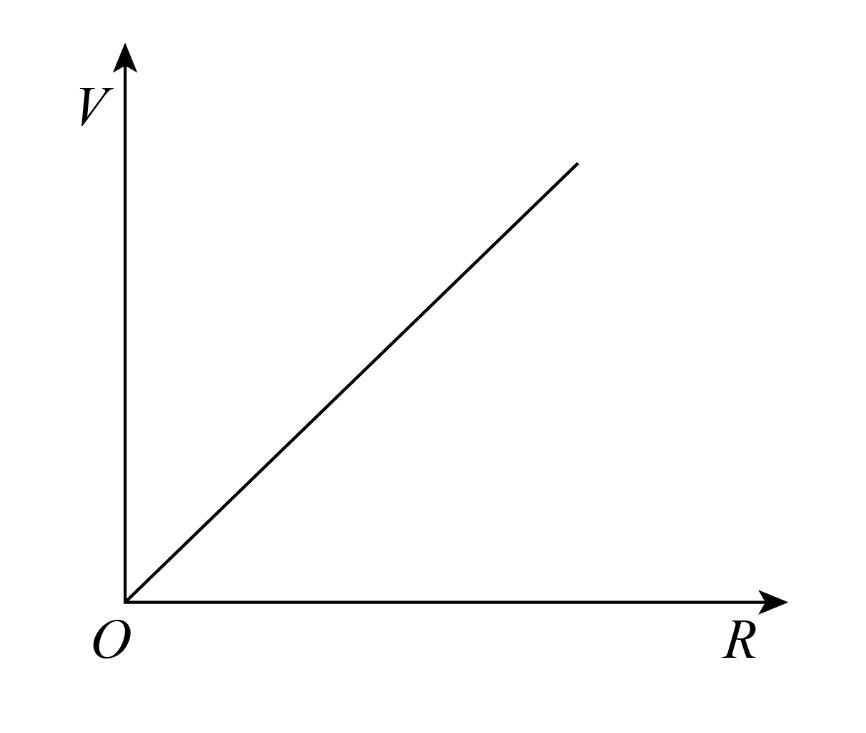
If the current supplied to a variable resistor is constant, draw a graph between voltage and resistance.
Answer
480.6k+ views
Hint:
When there are two points in the circuit, then according to the ohm’s law, the amount of current (I) will be directly related to potential difference or the voltage (V) between these points. This relation provides information about the resistance (R), which is the constant of proportionality for the relation of voltage and current in ohm’s law.
Complete step-by-step solution:
Let we have the voltage $V$ and the variable resistor $R$, and the constant supplied current is $I$ .
Now we will write the relation between voltage $V$ , current $I$ and the Resistance $R$ using the ohm’s law.
$V = IR$
It is given that the current supplied to the variable resistor is constant, so the voltage in the above expression will be directly proportional to the resistance.
Now we write the expression after taking the current constant.
$V \propto R$
It means as the voltage increases the value of resistance will also increase and if the voltage decreases the value of the resistance will also decrease.
This relation shows the linear relationship of voltage and the resistance with a constant slope.
The value of the slope of the above relation is constant and that is equal to value of the current.
The schematic diagram of the above relation between voltage $V$ and the variable resistance $R$ is given as follows,

In the above diagram the vertical line represents the voltage and the horizontal line shows variable resistant.
Note:
In a circuit, the voltage or the potential difference provides the information about the amount of work that is needed to move a test charge from a point to another point and the current provides the information about the rate of the flow of electric charges.
When there are two points in the circuit, then according to the ohm’s law, the amount of current (I) will be directly related to potential difference or the voltage (V) between these points. This relation provides information about the resistance (R), which is the constant of proportionality for the relation of voltage and current in ohm’s law.
Complete step-by-step solution:
Let we have the voltage $V$ and the variable resistor $R$, and the constant supplied current is $I$ .
Now we will write the relation between voltage $V$ , current $I$ and the Resistance $R$ using the ohm’s law.
$V = IR$
It is given that the current supplied to the variable resistor is constant, so the voltage in the above expression will be directly proportional to the resistance.
Now we write the expression after taking the current constant.
$V \propto R$
It means as the voltage increases the value of resistance will also increase and if the voltage decreases the value of the resistance will also decrease.
This relation shows the linear relationship of voltage and the resistance with a constant slope.
The value of the slope of the above relation is constant and that is equal to value of the current.
The schematic diagram of the above relation between voltage $V$ and the variable resistance $R$ is given as follows,

In the above diagram the vertical line represents the voltage and the horizontal line shows variable resistant.
Note:
In a circuit, the voltage or the potential difference provides the information about the amount of work that is needed to move a test charge from a point to another point and the current provides the information about the rate of the flow of electric charges.
Recently Updated Pages
How do you factor x2 + x 20 0 class 9 maths CBSE

How do you solve y6x and 2x+3y20 using substitutio class 9 maths CBSE

Chipko movement originated in Gopeshwar in A 1953 B class 9 biology CBSE

The adjacent sides in the parallelogram are supplementary class 9 maths CBSE

The compound used in plastic industry is A Vinyl acetate class 9 chemistry CBSE

How do you solve for y in 2left y dfrac12 right 4left class 9 maths CBSE

Trending doubts
Write the difference between soap and detergent class 10 chemistry CBSE

When was Shivaji born A 1632 B 1627 C 1678 D 1634 class 10 social science CBSE

a Why did Mendel choose pea plants for his experiments class 10 biology CBSE

State and explain Ohms law class 10 physics CBSE

The Equation xxx + 2 is Satisfied when x is Equal to Class 10 Maths

Differentiate between Food chain and Food web class 10 biology CBSE




